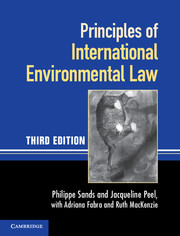Book contents
- Frontmatter
- Contents
- Foreword
- Preface and acknowledgments to the first edition
- Preface and acknowledgments to the second edition
- Preface and acknowledgments to the third edition
- Table of cases
- Table of treaties and other international instruments
- Abbreviations
- Part I The legal and institutional framework
- Part II Principles and rules establishing standards
- Part III Techniques for implementing international principles and rules
- Part IV Linkage of international environmental law and other areas of international law
- 18 Human rights and armed conflict
- 19 International trade and competition
- 20 Foreign investment
- 21 Future developments
- Index
- References
21 - Future developments
from Part IV - Linkage of international environmental law and other areas of international law
Published online by Cambridge University Press: 05 June 2012
- Frontmatter
- Contents
- Foreword
- Preface and acknowledgments to the first edition
- Preface and acknowledgments to the second edition
- Preface and acknowledgments to the third edition
- Table of cases
- Table of treaties and other international instruments
- Abbreviations
- Part I The legal and institutional framework
- Part II Principles and rules establishing standards
- Part III Techniques for implementing international principles and rules
- Part IV Linkage of international environmental law and other areas of international law
- 18 Human rights and armed conflict
- 19 International trade and competition
- 20 Foreign investment
- 21 Future developments
- Index
- References
Summary
INTRODUCTION
The Stockholm Conference is widely regarded as the moment of ‘birth’ of modern international environmental law, so its fortieth anniversary is an apt time to reflect on what international environmental law has since achieved, as well as the challenges that lie in the future. Since the first edition of this book was published in 1994, international environmental law has become an important disciplinary area within the broader field of international law. Its focus is regulation of ‘the environment’, which encompasses both the natural world and human interactions with it, and is characterised by a complex system of interconnections. The interdependence of environmental issues poses a constant challenge for international law: how to develop and apply a comprehensive and effective set of legal requirements that will prevent environmental damage by addressing the sources, without taking measures that will cause harm elsewhere.
Over the past four decades, significant steps have been made towards the development of a comprehensive and effective legal framework to address environmental issues. In the field of international law-making and regulation by states – still the principal actors in international environmental law – notable achievements include: the development and progressive tightening of controls on the production and consumption of ozone-depleting substances under the 1987 Montreal Protocol, credited with reversing the trend towards depletion of the ozone layer; the establishment by UNEP of a network of regional seas conventions and protocols covering the world's oceans; the elaboration of a regime for the conservation and sustainable use of biodiversity incorporating two major protocols (on biosafety and access to genetic resources) as well as a supplementary liability protocol to the biosafety regime; the introduction of landmark rules in the 1998 Aarhus Convention to promote greater public involvement in decision-making, through information, participation and access to justice in environmental matters; and the growing willingness of international courts to address environmental issues, even if they often reflect a cautious, timid approach.
- Type
- Chapter
- Information
- Principles of International Environmental Law , pp. 888 - 897Publisher: Cambridge University PressPrint publication year: 2012



